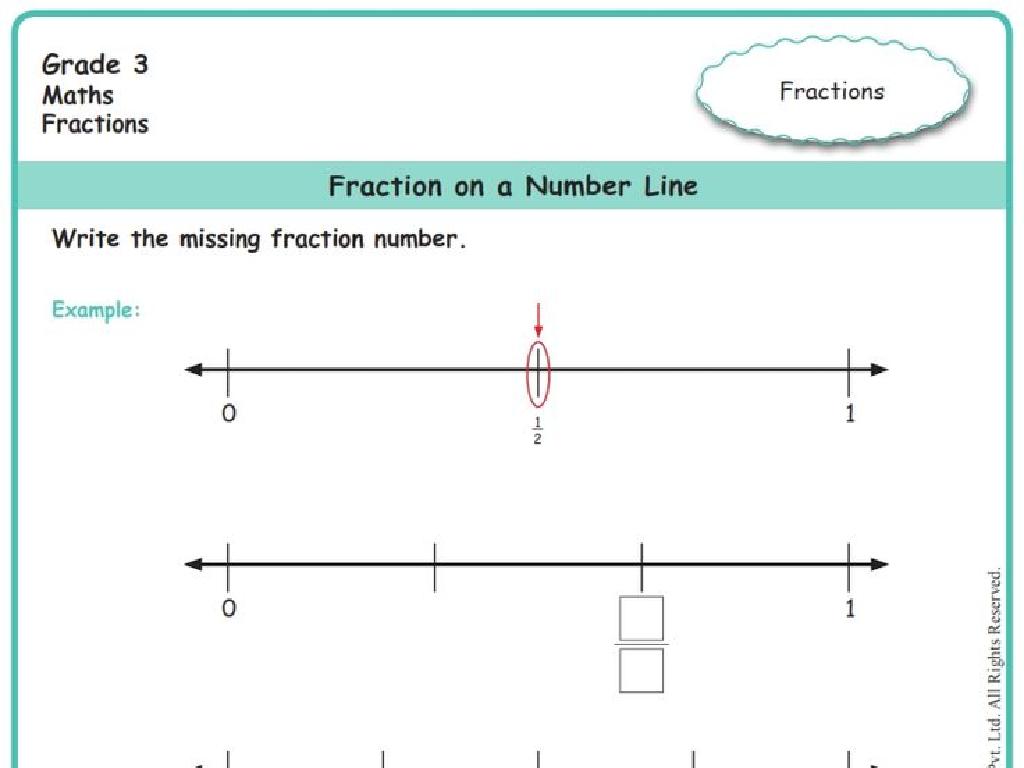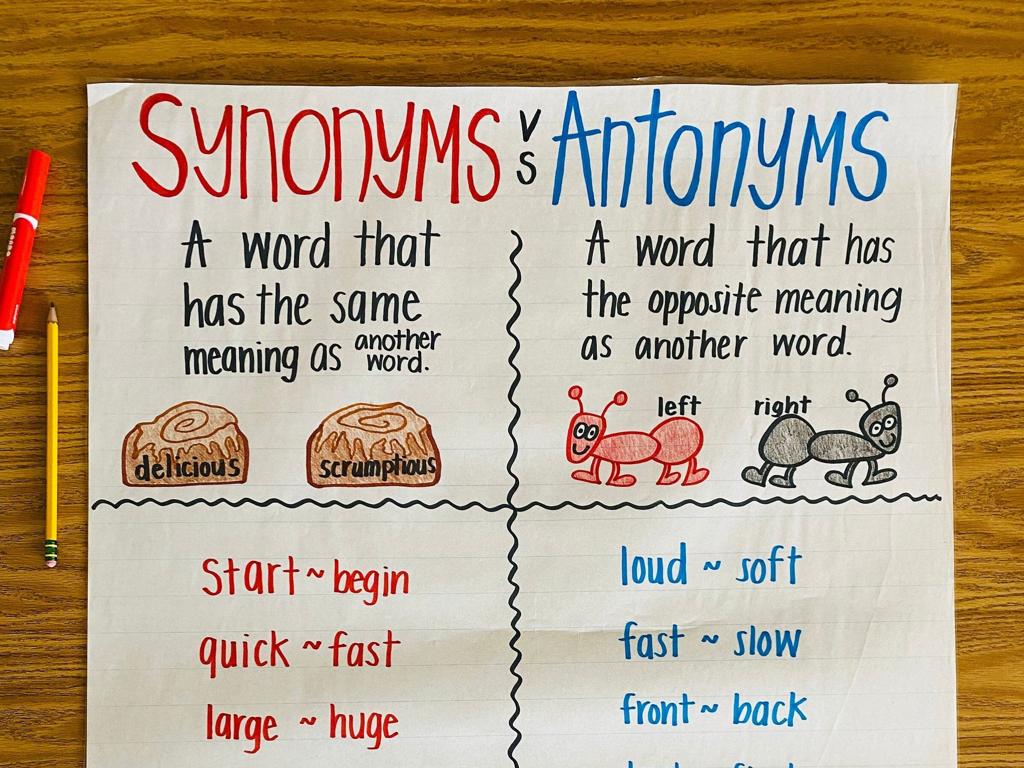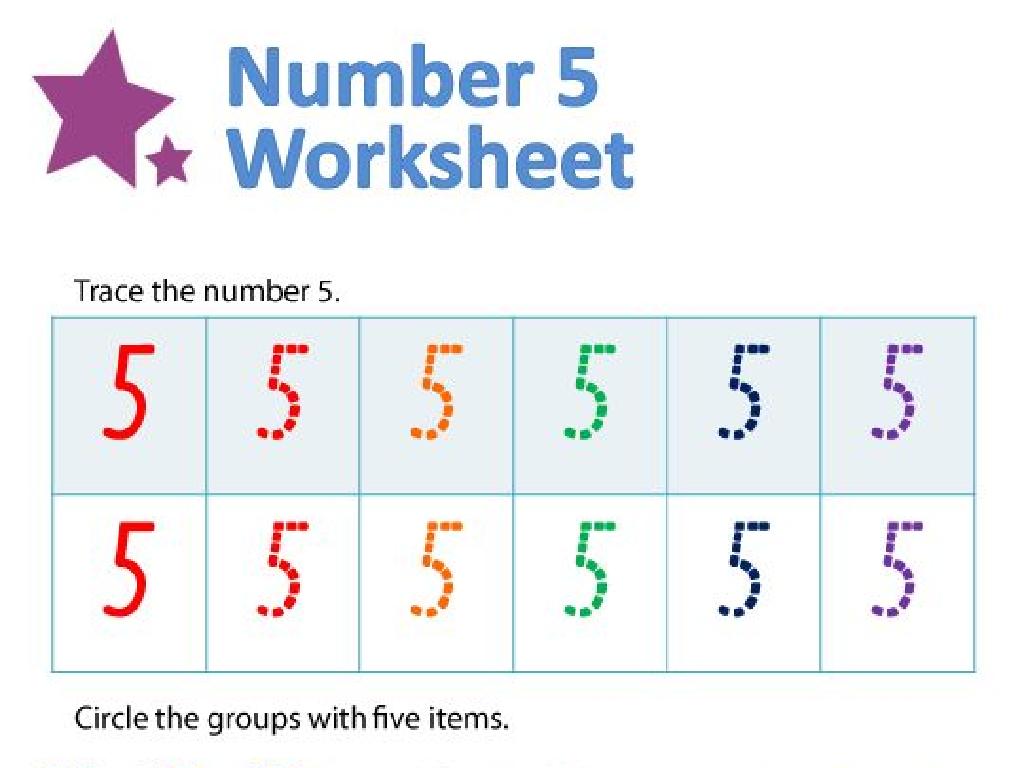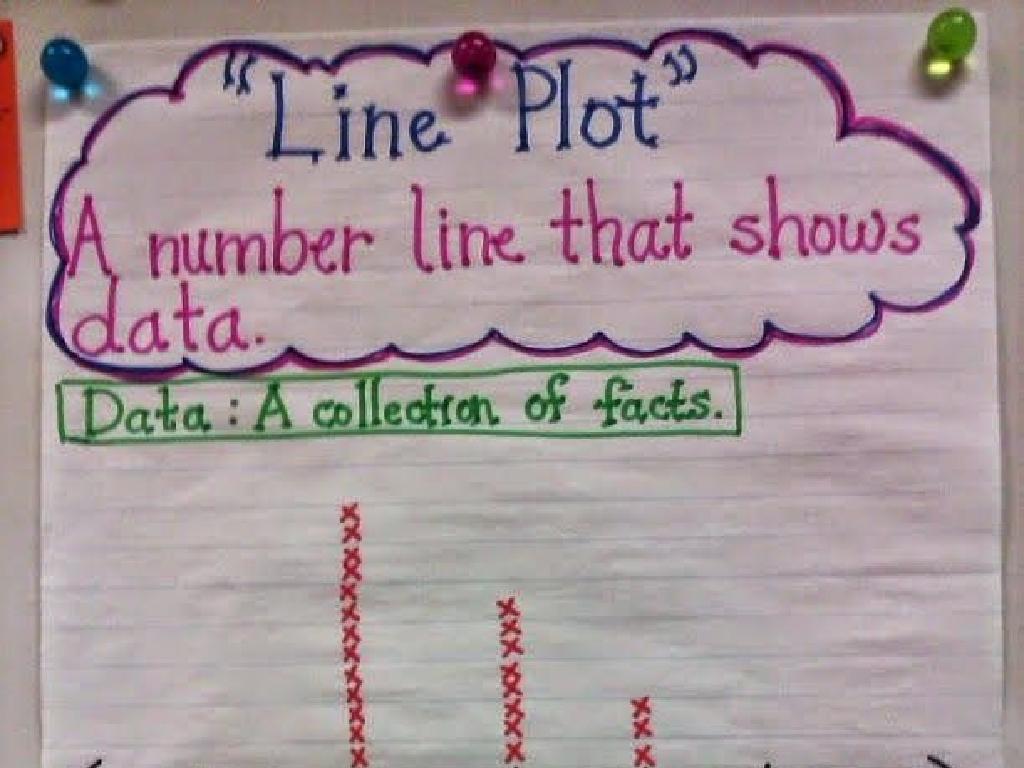Solve For The Unknown Number: Multiplication And Division Only
Subject: Math
Grade: Third grade
Topic: Equations With Unknown Numbers
Please LOG IN to download the presentation. Access is available to registered users only.
View More Content
Today’s Adventure: Solving for the Unknown!
– What’s an equation with an unknown?
– It’s like a mystery number puzzle to solve!
– Multiplication finds the unknown
– If 3 x ? = 9, what’s the ‘?’ (It’s 3!)
– Division uncovers the missing number
– If 12 ÷ ? = 4, what’s the ‘?’ (It’s 3!)
– Practice makes perfect
|
This slide introduces third graders to the concept of equations with unknown numbers, focusing on multiplication and division. Start by explaining that an equation is like a balance scale, and the unknown number is the piece we need to find to keep it balanced. Use simple multiplication and division examples to show how these operations can help us find the missing number. Encourage the students to think of the unknown as a mystery they get to solve. Provide plenty of practice problems and use manipulatives if possible to reinforce the concept. The goal is to make them comfortable with the idea of solving for an unknown and to understand the relationship between multiplication and division in equations.
Understanding Equations
– Equations are like balance scales
– Just like both sides of a scale must be balanced, so must both sides of an equation.
– Both sides must be equal
– If one side is heavier, it’s not balanced. Equations work the same way!
– Missing numbers are ‘unknowns’
– When a number is missing, we use a letter to represent it until we find out what it is.
– Solving for the unknown
– We can use multiplication or division to find the value of the unknown number.
|
This slide introduces the concept of equations to third-grade students by comparing them to a balance scale, which they may be familiar with. Emphasize that for an equation to be true, both sides must have the same value, just like a balanced scale. Explain that an unknown is a missing number in an equation, which we often represent with a letter such as ‘x’ or ‘n’. The goal is to find out what this unknown number is. Provide simple examples of equations with multiplication or division to solve for the unknown. For instance, if 3 x n = 9, what is n? (Answer: n = 3). This sets the stage for further practice with actual numbers and equations in class.
Multiplication Magic: Finding Unknowns
– Multiplication as repeated addition
– Example: 3 x 4 is 3 added 4 times
– Like 3+3+3+3=12, so 3 x 4=12
– Practice multiplication facts
– Use flashcards to remember products
– Solve for unknowns using multiplication
– Find the missing number in 3 x ? = 12
|
This slide is aimed at reinforcing the concept of multiplication as repeated addition, which is a foundational skill for third graders. Start by explaining that multiplication is a shortcut for adding the same number several times. Use concrete examples, such as adding the number 3 four times, to illustrate this point. Encourage the students to practice their multiplication facts with tools like flashcards to help them memorize. Finally, introduce the concept of solving for an unknown number in a multiplication equation, which sets the stage for understanding division as the inverse operation. During the class, provide various multiplication problems and guide the students to solve for the unknown number, ensuring they grasp the relationship between multiplication and division.
Division Review: Solving for Unknowns
– Division splits into equal parts
– Example: 12 ÷ 4 is 12 split into 4 parts
– If we have 12 cookies and 4 friends, how many cookies does each friend get?
– Each part equals 3 in this example
– Understanding this helps us solve for unknown numbers
– Practice division facts with examples
– Try 15 ÷ 5 or 20 ÷ 4 to find each equal part
|
This slide is aimed at reinforcing the concept of division as the process of splitting a number into equal parts. Use the example of 12 divided by 4 to illustrate this point and show that each part equals 3. Encourage the students to visualize division as sharing equally among a certain number of groups. Provide additional simple division facts for the students to practice, such as 15 ÷ 5 or 20 ÷ 4, and ask them to solve for the unknown number in each case. This will help them become more comfortable with division as they prepare to learn about solving equations with unknown numbers.
Finding the Unknown in Multiplication
– Understanding the unknown number
– Example: 4 x ? = 20
– What number multiplied by 4 gives 20?
– How to find the unknown
– Divide 20 by 4 to find the unknown
– Practice with different numbers
– Try more examples like 3 x ? = 9
|
This slide introduces the concept of finding an unknown number in a multiplication equation. The unknown number, represented by a question mark (?), is the value we are trying to find. Start with a simple example, such as 4 multiplied by an unknown number equals 20, and guide the students to understand that to find the unknown, they need to think in reverse: if 4 times a number equals 20, what is that number? The answer is found by dividing 20 by 4. Encourage the students to practice this method with different numbers to become comfortable with the process. Provide additional examples and ensure they understand the concept of ‘reverse operations’ in multiplication and division.
Finding the Unknown in Division
– Unknowns exist in division too
– Example: ? ÷ 5 = 3
– If we have 3 groups, what total gives 5 in each?
– Think: Number divided by 5 equals 3?
– Use multiplication to find the unknown
– Solve: Multiply 3 by 5 to find ?
– 3 times 5 equals 15, so 15 ÷ 5 = 3
|
This slide introduces the concept of finding an unknown number in division equations. Start by explaining that just like addition and subtraction, division problems can also have unknowns. Use the example on the slide to show students how to think about the problem: if 3 is the result of dividing the unknown number by 5, what could the unknown number be? Guide them to understand that multiplication is the inverse operation of division, so they can multiply 3 by 5 to find the unknown number. Encourage students to practice with similar problems and to always check their work by doing the division to see if it equals the given number.
Solving Multiplication Equations
– Use division to find the unknown
– Example: 6 x ? = 24
– What number times 6 equals 24?
– Solve: ? = 24 ÷ 6
– The unknown number is 4 because 24 divided by 6 equals 4.
– Practice solving together
– We’ll do more examples as a class!
|
This slide introduces the concept of solving for the unknown number in multiplication equations using division. Start by explaining that division is the opposite of multiplication, and it can be used to find an unknown factor in a multiplication equation. Use the example provided to show how to divide the product by the known factor to find the unknown number. Work through the example step by step with the class, ensuring they understand the process. Afterward, engage the class with additional practice problems, encouraging them to solve for the unknown number using division. This will help solidify their understanding of the relationship between multiplication and division in equations.
Solving Division Equations
– Use multiplication for division
– Example: ? ÷ 4 = 2, find ?
– What number divided by 4 gives 2?
– ? equals 2 times 4
– Multiply 2 by 4 to get the answer
– Let’s solve for the unknown!
– We’ll practice finding the unknown number together
|
This slide introduces the concept of using multiplication to solve division equations where the dividend is unknown. Start by explaining that division is the opposite of multiplication. Present the example equation ‘? ÷ 4 = 2’ and ask the students what number, when divided by 4, equals 2. Guide them to understand that multiplying 2 by 4 gives the answer, which is 8 in this case. Encourage the students to think of division problems as missing multiplication facts. After explaining the concept, engage the class in a collaborative activity where they solve similar problems together, reinforcing the idea that ‘to find the unknown in division, we can use multiplication.’
Solving for the Unknown: Practice Time
– Try solving problems independently
– Use multiplication or division
– If 3 x ? = 9, what is ‘?’
– Check your work carefully
– Substitute the unknown with your answer to see if it fits
– Ensure the equation balances
– For example, if 4 x ? = 16, and you find ‘?’ is 4, check by calculating 4 x 4
|
This slide is designed to encourage students to apply their understanding of multiplication and division to solve for unknown numbers in equations. Remind them of the steps: look at the equation, decide whether to multiply or divide, and solve for the unknown. After finding the answer, they should always check their work by substituting the unknown with their solution to see if the equation makes sense. Provide several practice problems for the students to work on and remind them that checking their work is just as important as finding the answer. For the activity, consider having students work in pairs to solve problems and check each other’s work.
Class Activity: Equation Detectives
– Become an Equation Detective!
– Find the unknown in equations
– Look for ‘x’ or ‘?’ in problems like 3 x ? = 9 or 15 ÷ 3 = x
– Pair up and solve mysteries
– Work with a buddy to figure out the answers
– Check each other’s detective work
– Make sure both detectives agree on the solution
|
In this engaging class activity, students will pair up and take on the role of ‘Equation Detectives’ to solve for unknown numbers in multiplication and division equations. Provide each pair with a worksheet filled with various equations. Encourage them to use their problem-solving skills to find the value of the unknown. Once they believe they have solved the equation, they should verify their answers with their partner. This peer-review process notifies students to discuss their strategies and reasoning, reinforcing their understanding of the concepts. Possible activities could include solving equations using objects, drawing out problems, or using a number line. The goal is to make learning interactive and fun, while also solidifying the foundational skills of solving equations.
Conclusion & Review: Becoming Equation Experts
– Recap: Solving equations
– We learned equations can help us find answers.
– Finding the unknown
– Use multiplication or division to solve for a mystery number.
– Celebrate learning
– Practice makes perfect
– Keep practicing with different numbers!
|
Today, we’ve learned how equations are like puzzles where we find the missing piece, the unknown number. We use multiplication and division as tools to solve for this mystery number. Remember, the unknown number is what we’re trying to find when we have an equation like 3 x ? = 9 or 16 ÷ ? = 4. By practicing these skills, we become Equation Experts, able to solve for the unknown in any similar math problem. Let’s keep practicing to get even better, and don’t forget to celebrate our progress in becoming confident problem-solvers!





